
Leaves come in many shapes and sizes, and the veins which transport water and nutrients to and from the stems of the plant form beautiful branching patterns. (It is interesting to ask children what they think the function of these veins might be. It's really not very different to the veins in our own bodies, which you can point out to them.)
These patterns can be transferred onto paper very simply, by painting the underside of a leaf and then pressing it onto the paper surface using a roller, a pad of paper or just (rather messily!) the fingers. Best results will be obtained with strongly coloured paint, such as acrylic or poster paints, or inks. Be sure that whatever you use will wash off hands and clothes with water, though. Watercolours will also work if they are strong enough - e.g. from tubes rather than from watercolour "pans".
There is no need to restrict yourself to one colour per leaf. Especially in autumn you can encourage children to notice the range of colours in the leaves - greens, yellows, oranges, reds, browns and even purples. They could apply several areas of colour to a single leaf and let them mix on the leaf before printing. Notice what happens when two colours combine. This way they can learn about colour mixing.
Here are some other ideas for things to do with leaves:-
- Go on a leaf hunt, collecting leaves of different shapes, sizes and colours. This is especially good in the autumn, of course.
- Leaf prints can be used to construct a larger picture, such as a face or a butterfly. Details can be added with a felt tip pen.
- Leaves can also be pressed to preserve them. This can be done with a flower press, but inserting leaves between two sheets of paper inside a book or beneath a heavy weight will work perfectly well. The same thing can be done with petals, of course. Such pressed items can then be used in collages, stuck on with any suitable glue, such as PVA glue or wallpaper paste. You can also incorporate them into Nature mobiles.
- Leaves can also be used to create mobiles, wreaths, masks and many other items which children can play with or display in their bedroom. Ideas can be found at web sites such as this one from the Woodland Trust, or this from the USA.